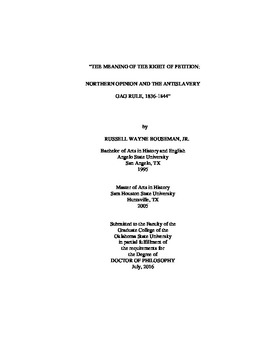| dc.contributor.advisor | Rohrs, Richard | |
| dc.contributor.author | Bouseman, Russell Wayne, Jr. | |
| dc.date.accessioned | 2017-02-22T22:08:40Z | |
| dc.date.available | 2017-02-22T22:08:40Z | |
| dc.date.issued | 2016-07 | |
| dc.identifier.uri | https://hdl.handle.net/11244/48785 | |
| dc.description.abstract | In the 1830s, a national movement against slavery organized in the United States. One of the actions taken by slavery opponents was to petition Congress, most commonly for the abolition of slavery in the District of Columbia. Congressmen had occasionally received such petitions in the past, but beginning with the commencement of the 24th Congress in 1835, the number of petitions became overwhelming. Southerners objected to these petitions believing that if Congress seriously entertained abolition in the nation's capital, then northerners would seek to abolish slavery in the states. Because slavery was such a divisive issue, many northern Democrats concurred that the presentation of antislavery petitions was discordant. Members of the Senate and the House of Representatives attempted to prevent these petitions from becoming contentious and hindering the workings of the federal government. The Senate adopted a successful "receive-and-reject" rule, which received the petitions but rejected their requests. The House established a Gag Rule, which effectively denied Americans the right to petition regarding slavery. | |
| dc.description.abstract | Rather than mute discussion of slavery, the House became embroiled in a nine-year battle over the meaning of the right of petition. Initially, many northern Democrats allied with southerners to support the Gag Rule. This quickly became an untenable position as it only led to more petitions, encouraged abolitionists, and evoked increased outrage in the northern press. Eventually, the resistance in the North was so great that the House rescinded the Gag Rule in December 1844. This dissertation examines northern opinion regarding the Gag Rule, relating the many reasons people opposed it, why northerners supported it, and how it intensified sectionalism in American politics. The petition drive to abolish slavery in the District of Columbia led to the establishment of the Gag Rule, which rapidly became more about placating the interests of the South while restricting the liberties of northern white Americans. Opponents fought ardently against the abridgment of their First Amendment right of petition—and speech as well. This dissertation relates that struggle. | |
| dc.format | application/pdf | |
| dc.language | en_US | |
| dc.rights | Copyright is held by the author who has granted the Oklahoma State University Library the non-exclusive right to share this material in its institutional repository. Contact Digital Library Services at lib-dls@okstate.edu or 405-744-9161 for the permission policy on the use, reproduction or distribution of this material. | |
| dc.title | Meaning of the right of petition: Northern opinion and the antislavery Gag Rule, 1836-1844 | |
| dc.contributor.committeeMember | Huston, James | |
| dc.contributor.committeeMember | Williams, Elizabeth | |
| dc.contributor.committeeMember | Burkholder, Kristen | |
| dc.contributor.committeeMember | Van Delinder, Jean | |
| osu.filename | Bouseman_okstate_0664D_14836.pdf | |
| osu.accesstype | Open Access | |
| dc.type.genre | Dissertation | |
| dc.type.material | Text | |
| thesis.degree.discipline | History | |
| thesis.degree.grantor | Oklahoma State University | |
